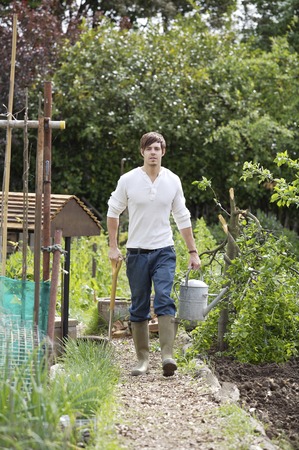A Brief History of British Allotments
To truly understand the fabric of British allotment culture, it’s important to first look back at where it all began. The story of allotments in the UK stretches as far back as the Victorian era, when rapid industrialisation drew people from rural villages into crowded city streets. Back then, small parcels of land were set aside for working families, allowing them a patch to grow their own food and maintain a link with nature. These early plots weren’t just about sustenance; they offered a vital sense of community and self-sufficiency during uncertain times.
The role of allotments became even more crucial during both World Wars. With food shortages biting hard, the government encouraged citizens to “Dig for Victory,” transforming lawns, parks, and wasteland into thriving vegetable patches. Allotments became a patriotic duty—a way for ordinary folk to pull together, share knowledge, and provide for their neighbours. This wartime spirit left a lasting mark on how communities viewed these shared spaces.
In the decades that followed, interest in allotments waxed and waned alongside social trends and economic pressures. However, in recent years there has been a notable revival. Concerns about food miles, sustainability, and well-being have drawn new generations to the humble allotment plot. Today’s sites are vibrant places where tradition meets modern values—a blend of old hands passing down wisdom and newcomers eager to reconnect with the land. From their Victorian roots to their contemporary renaissance, British allotments remain a cherished part of community life, steeped in history and brimming with stories waiting to be uncovered.
2. The Allotment Community: More Than Gardening
When you step into a British allotment, you’re not just entering a patch of land for growing your own vegetables—you’re joining a vibrant community with traditions and camaraderie that stretch back generations. Allotments in the UK are often hubs of neighbourly spirit, where people from all walks of life come together, united by their love of gardening and the outdoors.
The sense of community here is truly unique. Plot holders range from seasoned retirees happy to share their decades of wisdom, to young families introducing their children to the joys of sowing seeds. Conversations over low fences or at communal compost heaps are common, and advice is always freely given—be it on the best way to deter slugs or how to coax reluctant runner beans to climb. Sharing goes beyond words, too; it’s tradition for gardeners to swap surplus produce, especially during bumper harvests. Courgettes, for example, are notorious for growing in abundance, and you’ll often find a friendly neighbour offering a basketful with a knowing smile.
Below is a quick overview of how community life typically unfolds on an allotment:
| Aspect | What You’ll Experience |
|---|---|
| Friendly Advice | Tips on planting, pest control, and crop rotation passed down from veteran gardeners. |
| Produce Swaps | Exchanging excess fruit or vegetables—especially during gluts (courgettes, anyone?). |
| Community Events | Annual shows, seed swaps, BBQs, and working parties to maintain shared spaces. |
| Shared Resources | Access to communal sheds, tools, water tanks, and sometimes even chickens! |
| Storytelling & Tradition | Tales of past harvests and local folklore shared over tea breaks in the shed. |
This neighbourly culture means that even beginners never feel alone. On allotments up and down the country, newcomers quickly discover that learning is as much about listening and sharing as it is about digging and sowing. In time, you’ll not only grow your own food but also become part of a living tradition—one where friendships flourish alongside runner beans and raspberries.

3. Traditions and Unspoken Etiquette
Stepping into the world of British allotments means immersing yourself in a tapestry of time-honoured customs and subtle codes of behaviour that have evolved over generations. These traditions aren’t just quaint add-ons—they’re the glue that binds allotment communities together, fostering goodwill and mutual respect among plot holders.
Sharing Surplus Produce
One of the most cherished customs on British allotments is the sharing of surplus fruit and vegetables. When a bumper crop of courgettes or runner beans arrives, it’s almost expected that you’ll offer your excess to fellow gardeners or leave a basket at the gate for anyone in need. This spirit of generosity not only prevents waste but also helps forge lasting friendships across the site.
Respecting Boundaries
While camaraderie is abundant, so too is the importance of respecting each other’s space. It’s an unspoken rule never to tread on someone else’s plot without permission, nor to help yourself to their produce—no matter how tempting those ripe strawberries might look over the fence. Plot boundaries are sacrosanct, marked by simple string lines or low fences, serving as gentle reminders to keep to your own patch unless invited otherwise.
Quiet Rituals and Community Spirit
Long-time allotmenteers often adhere to certain routines: early morning watering, stopping for a cuppa in the shed, or exchanging gardening tips over the compost heap. There’s a rhythm to these shared spaces—a nod and a smile as you pass each other, or a quiet word if you spot a fellow grower struggling with pests. Lending a hand is always appreciated, but interfering or giving unsolicited advice can ruffle feathers.
The Art of Discretion
British politeness prevails even on the allotment. If you notice weeds taking over next door or a structure that looks a bit precarious, it’s best to keep comments tactful or offer help in a roundabout way. Allotment life values discretion and gentle encouragement over criticism.
A Place for Tradition and Change
Though many customs endure, each site will have its own quirks—annual shows, communal work days, or even competitions for the largest marrow. As a newcomer, observe quietly at first; soon enough, you’ll find yourself part of these time-honoured rituals that make British allotment culture truly unique.
4. Key Rules and Regulations for Beginners
Stepping into the world of British allotments is not just about planting seeds and hoping for a good harvest—there are some essential rules and guidelines that every new plot holder needs to get their head around. These regulations, which may vary slightly from site to site, help keep things running smoothly and ensure everyone enjoys their bit of green space.
General Guidelines
Allotment sites across the UK are typically governed by a combination of local council regulations and site-specific rules set by the allotment association. The basics are fairly straightforward, but as any seasoned plot-holder will tell you, its always best to double-check with your own site’s committee. Here’s what you’ll generally need to keep in mind:
| Category | What You Should Know |
|---|---|
| Cultivation Requirements | You’re expected to cultivate at least 75% of your plot, usually with fruit, veg or flowers. The remaining area can be used for paths, compost bins, or a small seating spot. |
| Weed Control | Plots must be kept tidy and reasonably weed-free. Overgrown plots can lead to warnings or even eviction if left unattended. |
| Plot Boundaries | You must respect the boundaries of your plot—no encroaching on neighbours’ space or communal paths. |
| Paths & Access | Keep pathways clear and accessible for all users. Shared access is a hallmark of good allotment etiquette. |
Structures and What You Can (and Cant) Build
Many new allotmenteers get excited about putting up sheds, greenhouses or polytunnels, but there are usually some strict rules about what’s allowed:
| Structure Type | Typical Rules |
|---|---|
| Sheds & Greenhouses | Usually permitted but must adhere to size restrictions (often no larger than 6×8 feet). Placement may also require approval from the committee. |
| Polytunnels | Generally allowed if within size limits; always check before purchasing or constructing. |
| Permanent Fixtures (e.g., fences) | Permanent fences or walls are often not allowed; temporary low edging might be acceptable. |
| Lodging Overnight | No sleeping overnight on your plot is allowed—an allotment is strictly for daytime use only. |
| Livestock & Bees | You may be able to keep chickens or bees, but this almost always requires special permission and adherence to additional welfare guidelines. |
Additional Considerations for Newcomers
If you’re ever unsure about what’s permitted on your specific site, don’t hesitate to have a word with your site rep or pop along to an association meeting. Most long-standing members are happy to offer guidance—they’ve seen it all before! Following these rules isn’t just about ticking boxes; it’s part of joining a wider tradition where everyone does their bit to keep the community thriving. By understanding and respecting these guidelines early on, you’ll quickly earn your stripes as a valued member of the British allotment scene.
5. Getting Started: Tips for Your First Plot
So, you’ve made up your mind to join the wonderful world of British allotments—brilliant decision! Securing your first plot is often a matter of patience and persistence, as most sites have waiting lists. Start by contacting your local council or allotment association. Some folks put their name down on more than one list, just to increase their chances. While you wait, it’s wise to visit the site when possible; have a chat with current plot holders, ask questions, and get a real feel for the community spirit.
Essential Tools to Bring Along
Once your name comes up, you’ll want to be prepared. There’s no need to splash out on fancy kit in the beginning. A sturdy spade, fork, hoe, and a decent pair of gloves will see you through most jobs. Don’t forget a watering can—especially during those rare but precious hot British summers—and perhaps a wheelbarrow if your plot is far from the entrance. As you settle in, you can slowly add other bits: a hand trowel for delicate work, secateurs for pruning, and netting to fend off cheeky pigeons.
Making the Most of Your First Season
The best advice from seasoned hands is not to bite off more than you can chew. Focus on clearing a small section at a time; Rome wasn’t built in a day, and neither are great allotments! Start with easy crops like potatoes, courgettes, or runner beans—they’re forgiving and give you a taste of success early on. Talk to your neighbours—they’re often happy to share surplus seedlings or sage advice over a cuppa. Remember to keep pathways tidy and respect communal rules; good manners go a long way in this close-knit setting.
Building Good Habits Early
Set aside regular time each week for your plot—little and often works wonders. Keep an eye on notices about site meetings or tidy-up days; showing up is part of being in the community. Finally, don’t be shy about mistakes—everyone’s had their fair share of lost carrots or slug-munched lettuces. The important thing is to enjoy the process and savour the unique sense of achievement that comes with growing your own in true British allotment style.
6. Navigating Challenges and Celebrating Success
Every British allotment holder quickly learns that the path to a flourishing plot is rarely smooth. The unpredictable British weather—whether its relentless rain or an unexpected late frost—can test even the most seasoned gardeners patience. One minute you’re enjoying a spell of sunshine, the next you’re dashing out to cover delicate seedlings from a surprise cold snap. It’s wise to always keep an eye on the forecast and have fleece or cloches at the ready.
Pests: The Uninvited Guests
No discussion about allotment life would be complete without mentioning pests. Slugs, snails, aphids, and birds seem to know exactly when your crops are at their most tempting. Traditional British remedies include everything from beer traps for slugs to netting for berries and even a scarecrow or two—a nod to classic allotment charm. Engaging with fellow plot holders can also reveal time-honoured tricks passed down through generations.
The Time Crunch
For many beginners, balancing work, family, and the demands of an allotment can feel overwhelming. The key is little and often—regular visits make the work less daunting and help prevent small problems becoming big ones. Many old hands will tell you: “A weed in May is worth ten in June.” Embrace early morning or evening visits during summer; these quiet hours are perfect for both reflection and productivity.
Community Support and Shared Wisdom
Don’t be shy about seeking advice from neighbouring gardeners. Allotment culture in Britain thrives on camaraderie—whether it’s swapping surplus courgettes or sharing stories over a cuppa. Most sites also have noticeboards or WhatsApp groups where people post tips, request help, or celebrate small wins together.
Celebrating Your Harvest
After all the setbacks and hard graft, there’s nothing quite like that first handful of home-grown strawberries or a basket of runner beans straight from your own patch. Take time to enjoy these moments—perhaps with a picnic on your plot, or by entering your best produce in the local village show. These traditions are as much a part of British allotment life as digging and weeding.
A Tradition Worth Persevering
Remember, every challenge faced is part of what makes your successes so rewarding. With each season you’ll gain skills, confidence, and stories to share—becoming not just an allotmenteer, but a proud member of one of Britain’s most cherished communities.


